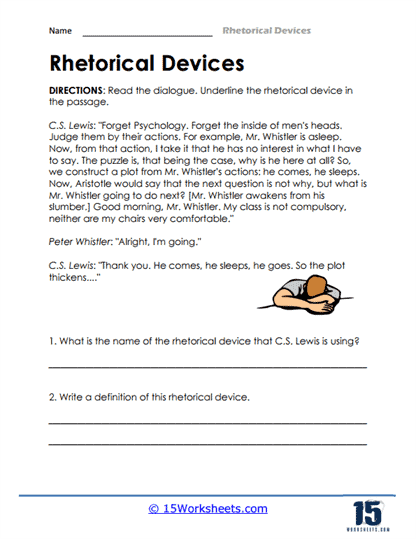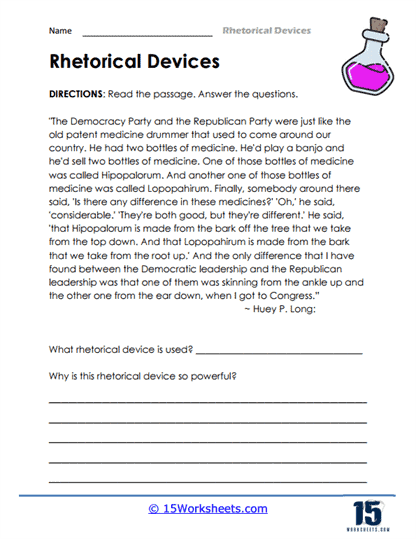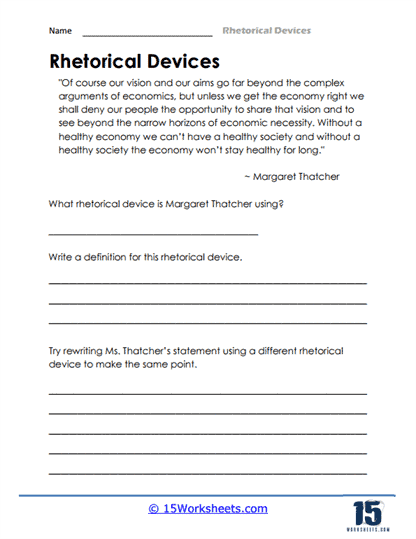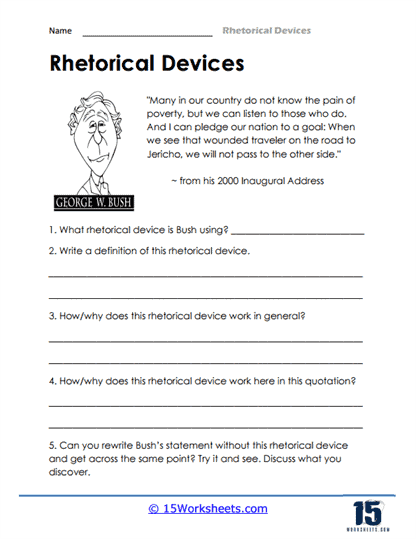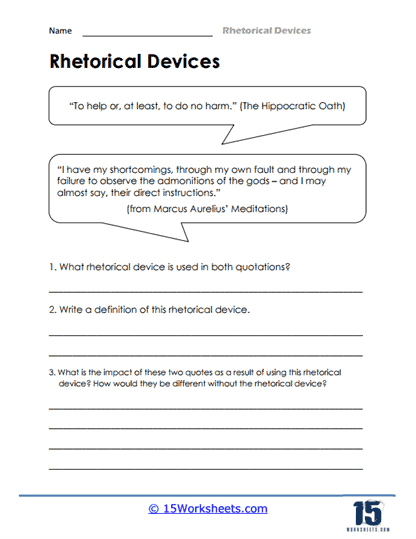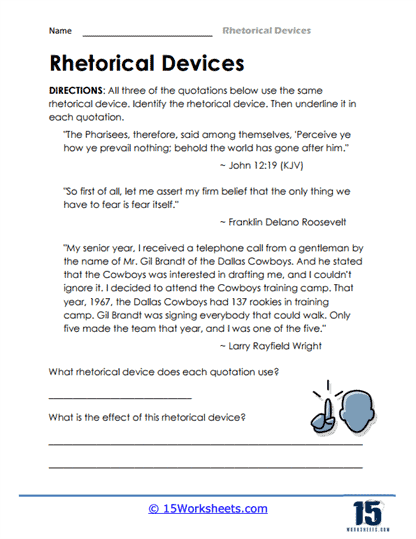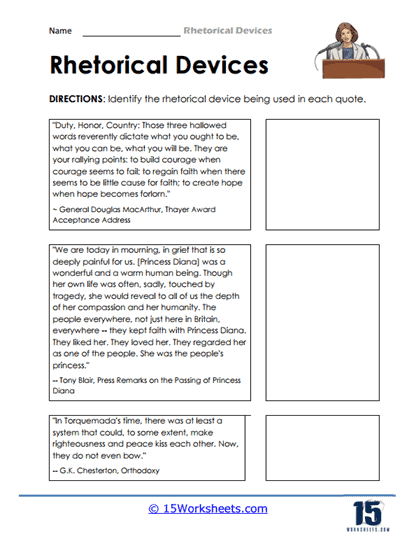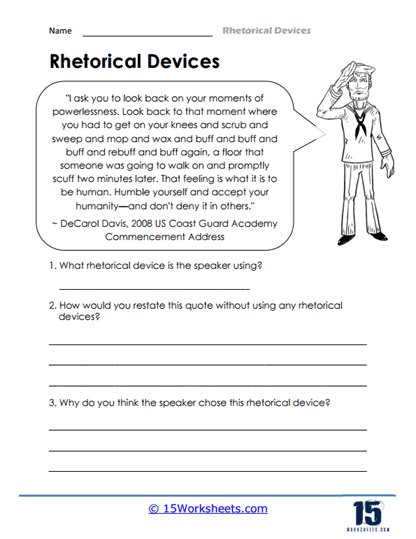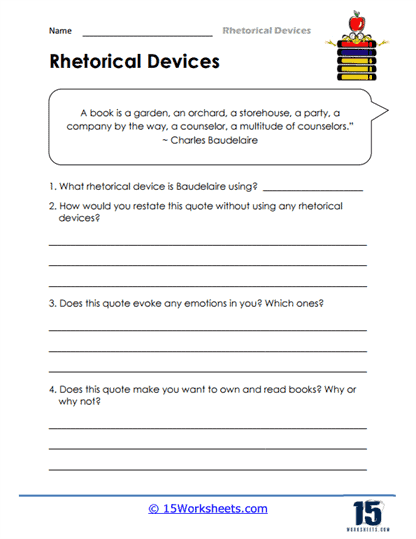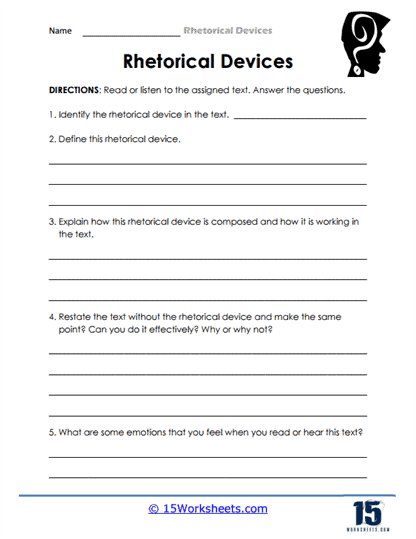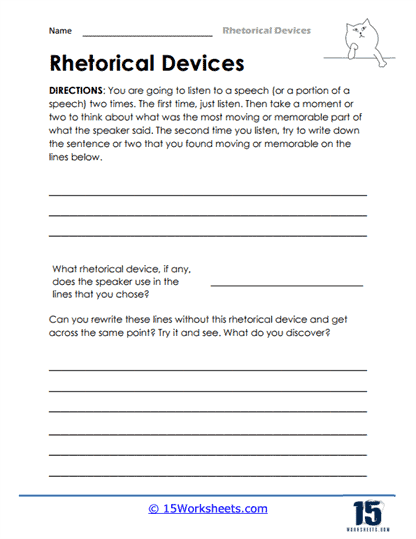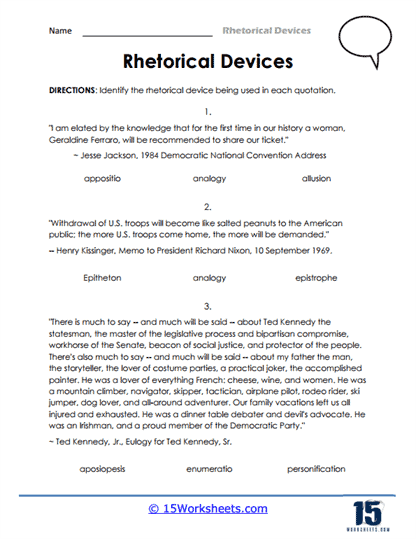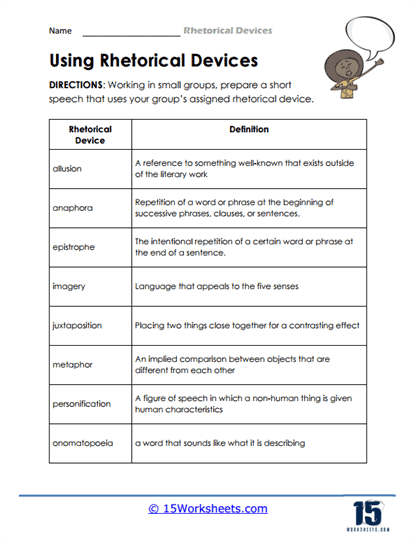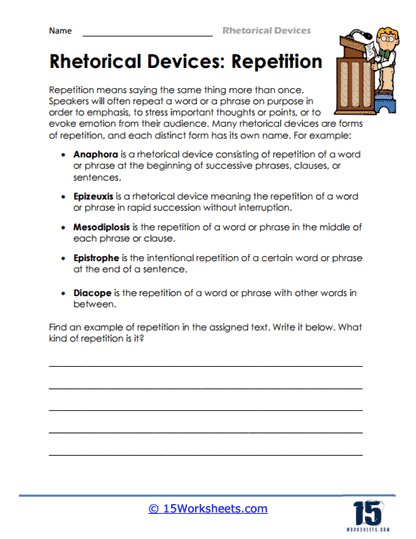Rhetorical Devices Worksheets
All About These 15 Worksheets
Rhetorical devices, the artful and strategic use of language to persuade, inform, or entertain, are essential tools for effective communication and critical thinking. Understanding rhetorical devices is not only important for enhancing writing and speaking skills but also for fostering persuasive communication, analytical abilities, and the capacity to engage meaningfully in various forms of discourse.
This collection of 15 worksheets is designed to introduce students to the world of rhetorical devices, helping them grasp the importance of these persuasive tools, recognize their various forms, and develop their own rhetorical prowess.
What Are Rhetorical Devices Worksheets?
These worksheets were created to help students understand and practice the use of various rhetorical devices. Rhetorical devices are techniques that speakers or writers use to convey their message more persuasively. These can include methods of persuasion, figures of speech, and other tools that make a piece of writing more effective.
The exercises on these worksheets are designed to help students identify and use rhetorical devices in their own writing and speech. They may include:
Identification – Students could be presented with passages of text and asked to identify the rhetorical devices used within them. This not only helps the students recognize these devices but also understand how they can be used effectively. For example, the students might have to find examples of alliteration, anaphora, or parallelism.
Analysis – The worksheets could contain exercises where students are asked to analyze how a particular rhetorical device is used in a passage or speech, and how it contributes to the overall message or effect of the piece.
Creation – Some exercises might involve students writing their own passages or speeches using a given rhetorical device. This can help students gain a more practical understanding of how these devices can be used effectively in their own writing.
Comparison – Students might be asked to compare the use of rhetorical devices in different texts, seeing how different authors use the same tool for different effects.
These types of exercises help students develop a more nuanced understanding of language and improve their own writing and speaking abilities. They will also become more perceptive readers, able to pick up on the subtle ways authors use language to convey their messages.
What is the Literary Device of Rhetorical Devices?
Rhetorical devices, often referred to as stylistic or literary devices, are techniques that writers and speakers use to convey their message more effectively or persuasively. These devices can help an author engage their audience by adding color, richness, and depth to their language. By using rhetorical devices, writers can create a connection with their audience, highlight certain points, evoke emotions, or create persuasive arguments.
Defining Features of Rhetorical Devices
Rhetorical devices can vary widely in their usage and effects. Some devices work on the level of word choice or sentence structure, while others involve the overall organization and development of a piece of writing. However, the main defining feature of all rhetorical devices is that they serve a specific purpose in the text, whether it’s to persuade, to evoke emotion, to add emphasis or clarity, or to make the text more memorable or engaging.
Examples of Rhetorical Devices in Literature
(Metaphor) “To Kill a Mockingbird” by Harper Lee
One of the most common and powerful rhetorical devices is the metaphor. A metaphor is a figure of speech that describes an object or action in a way that isn’t literally true, but helps explain an idea or make a comparison. In “To Kill a Mockingbird,” Harper Lee uses the metaphor of the mockingbird to represent innocence and goodness. As Atticus Finch tells his children, “it’s a sin to kill a mockingbird” because all they do is make music for people to enjoy—they do no harm and only give. This metaphor not only adds depth and richness to the novel but also helps to underline its main themes of innocence, morality, and injustice.
(Irony) “Pride and Prejudice” by Jane Austen
Irony is another powerful rhetorical device, which involves saying something that is the opposite of what you mean or having a situation turn out in a way that is opposite to what would be expected. Jane Austen uses irony expertly in “Pride and Prejudice,” often through her narrator’s comments or the dialogue of her characters. One of the most famous lines of the novel is its opening sentence – “It is a truth universally acknowledged, that a single man in possession of a good fortune, must be in want of a wife.” This line is ironic because it presents a societal expectation as a universal truth, and the events of the novel reveal the oversimplification and absurdity of such assumptions.
(Anaphora) “I Have a Dream” Speech by Martin Luther King Jr.
Anaphora is a rhetorical device where the same word or phrase is repeated at the beginning of successive clauses or sentences. This device is often used in speeches to add emphasis and rhythm. Martin Luther King Jr.’s “I Have a Dream” speech is a powerful example of anaphora. The repeated phrase “I have a dream” reinforces King’s vision and makes his message more memorable and persuasive. By repeating these words, King effectively emphasizes the hopes and aspirations of the Civil Rights Movement.
Rhetorical devices are integral tools in the hands of writers and speakers. They not only enhance the beauty and impact of the language but also deepen the audience’s understanding and appreciation of their messages. In each of the examples given, Harper Lee, Jane Austen, and Martin Luther King Jr. use rhetorical devices to underscore their themes, intensify emotional appeal, and create lasting impressions. By understanding these devices, one can become not only a more discerning reader but also a more persuasive and effective writer.
Benefits Of Rhetorical Devices Worksheets For Students
Exploring the world of rhetorical devices through this collection of 15 persuasion-enhancing worksheets offers students an opportunity to develop essential skills in effective communication, critical thinking, persuasive writing, media literacy, and cultural and historical awareness. Rhetorical devices are the building blocks of compelling communication and persuasive discourse.
By engaging with these exercises and activities, students not only enhance their academic abilities but also gain valuable tools for navigating the complexities of language and rhetoric in today’s world. The benefits of studying rhetorical devices extend far beyond the classroom, empowering students to be more persuasive, discerning, and culturally aware communicators in an increasingly interconnected and persuasive society.


